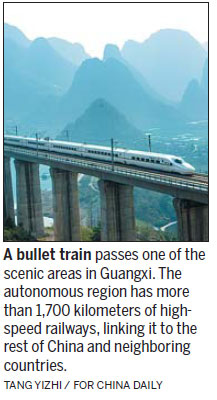Guangxi's trade soars, boosted by measures
The Guangxi Zhuang autonomous region in South China reported a foreign trade volume of 178.6 billion yuan ($27.57 billion) in the first half of this year, up 30 percent from the same period last year, according to the local statistics bureau.
Trade between Guangxi and the members of Association of Southeast Asian Nations reached 89.07 billion yuan in the first six months of the year, increasing 10.1 percent year-on-year.
Guangxi sustained the growth amid pressure from the continuing slowdown in global trade.
That was thanks to new trade facilitation measures implemented by the local government, according to an official. They included developing industrial parks and promoting international industrial capacity cooperation.
At present, shipping routes from the Beibu Gulf ports can reach many ASEAN member countries. A number of deepwater harbors are under construction.
Pan Wei, head of the autonomous region's transportation administration, said that Guangxi is focusing on developing closer ties with overseas port cities, to strengthen communications and trade with countries involved in the 21st Century Maritime Silk Road.

"We are making progress in infrastructure construction of our coastal ports, speeding up our pace in building an international shipping hub in our region," Pan said.
Qinzhou, by the Beibu Gulf, is one of the seaports that have witnessed steady growth in trade in recent years.
It recently welcomed a liquefied natural gas vessel with a load of 50,000 metric tons from the United States.
Zhang Lizhou, a pilot in Qinzhou, said that in recent years, more and more ships have arrived in and departed from Qinzhou Port.
In 2014, the number of the ships that were piloted into the port totaled 2,560, and by 2016, that number had increased to 3,680, according to Zhang.
Local officials in Guangxi said that in the long run the autonomous region would also step up investments in highways and railways, to supplement the shipping routes.
In the past three years, the high-speed railway network across Guangxi has extended to 1,737 kilometers.
There are now expressways to all the major border cities adjacent to ASEAN member countries.
The airports in Nanning, the autonomous region's capital city; and Guilin, China's renowned tourism city, have opened 23 flight routes to nine of the 10 ASEAN countries.
"We are working on three new highways, two railways and three new bridges, to reach the Indochina Peninsula," said Pang Huang, an official at the railway construction office in the autonomous region's government.
"We are aiming to make Guangxi a real hub for the Belt and Road Initiative."
liyou@chinadaily.com.cn
(China Daily 09/13/2017 page24)














